Trimming Overgrown Foot - Donkey
Jump to navigation
Jump to search

- The principles are basically the same as for routine trimming.
- The structural relationship between the coronary band and the distal phalanx is maintained. The whole overgrowth is composed of insensitive and often degenerate wall, sole and frog tissue.
- Donkeys often suffer from chronic foot disease with varying degrees of change.
- Good quality weight-bearing lateral radiographs are a very useful guide for trimming and prognosis.
- Excise degenerate material - e.g. seedy toe
- The white line is often enlarged as a result of disruption of normal laminar structure.
- Dress the hoof wall to restore the normal relationship between the hoof capsule and the distal phalanx.
- Consequently, the sole may need to bear more weight and enough thickness needs to be maintained to prevent excessive discomfort to the donkey. Provision of a deep bedded stable is also useful.
- Most donkeys respond well to improved angle of the foot without the need for prolonged analgesia. Daily inspection and good hoof hygiene are advisable as well as monthly farriery as indicated until a substantial hoof capsule has developed.
Literature Search
Use these links to find recent scientific publications via CAB Abstracts (log in required unless accessing from a subscribing organisation).
Hoof trimming in donkeys publications
|
|
This section was sponsored and content provided by THE DONKEY SANCTUARY |
|---|
